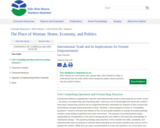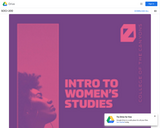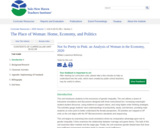
Gender Inequalities and the our experinces as a research team.
- Subject:
- Anthropology
- Material Type:
- Activity/Lab
- Author:
- Arthur Movsesyan
- Date Added:
- 12/17/2022

Gender Inequalities and the our experinces as a research team.

The course will focus primarily on contemporary discourses concerning gender inequality. Most of the readings assigned will be recent articles published in U.S. and British media capturing the latest thinking and research on gender inequality in the workplace. The class will be highly interactive combining case studies, videos, debates, guest speakers, and in-class simulations.

While the unifying focus of my unit will be the outcomes of globalization and trade in women’s lives, I have found it helpful to divide the content into two distinct sections—women in “developed” and “developing” nations around the world. The distinction between countries that fall under these labels was not based on my singular judgement, but rather a dichotomy that academics have discussed at length as emerging from the international trade system of the past several decades.1 Some common features that define nations considered “developed” in this system (to name just a few) include a service-based economy, an importation of goods produced from manufacturing/more labor-intensive industries, and a powerful voice in setting global trade regulations. In contrast, a few features that can be used to identify “developing” nations include an export-oriented economy, rapid urbanization, and the implementation of “shock therapy” structural adjustments promoted by global economic organizations. These distinct categories will provide a useful framework for students to gain a fundamental understanding of how different countries around the world interact with the same system. It would, of course, be more accurate to consider these categories as ends of a spectrum—with several nations existing somewhere in between “developing” and “developed.” I plan on addressing this nuance while not only introducing the unit, but also at various points throughout. By contrasting case studies from countries like the U.S. with Bangladesh, I plan to highlight the opposite ends of the same global system while working to avoid the promotion of a dichotomous, uncritical perspective of the world.

Provides an overview of the academic field of women’s studies, including the social and cultural consequences of living in a "gendered world." Socialization, communication, politics, crime, sexuality, and religion are examined, as well as the historical and cross-cultural aspects of gender relationships.

This unit introduces students to the economics of gender inequality. The unit utilizes a series of interactive simulations and discussions designed with three instructional foci: increasing meaningful student-student discourse, using evidence to support claims, and using higher-order thinking strategies. The activities gauge students’ tacit understandings of productivity, equity, and fairness, providing male students an entry point to better understand the female perspective. All activities are mapped to AP units so the unit aligns with the AP Microeconomics standards and sequencing.
This unit begins by examining how social revolutions driven by comparative advantage gave rise to gender inequality. It then examines the relationship between marriage and game theory. The bulk of this unit examines labor markets and the wage gap. Finally, the unit examines gender-biased laws that show how inefficient government regulation leads to greater social inefficiency.
Activities are designed for an 80-minute class with approximately 25 students. Lessons call for students to sit in small groups to facilitate discussion and collaboration. Students will need access to a computer and the internet to complete multiple activities.
As a word of warning, the activities are meant to help students learn to empathize with the disparity caused by gender inequality and may make some students uncomfortable. One activity is designed so students believe their grade is determined in a way that mirrors the wage gap. It may be helpful to give parents a heads up before completing the activity to let them know the experiment will not actually affect their grades disproportionally.
The essential questions of the unit are
1. What social inefficiencies naturally arise in American product and labor markets?
2. What role does the government play in correcting market failures?
3. How can society and the government change current legislature and policy to promote gender equality in the product and labor markets?

https://docs.google.com/presentation/d/1za7aE216EMrguOEpCtrysx-gMni6KDdvM9rU2UpNk2g/edit#slide=id.p